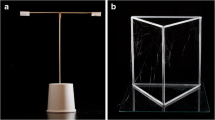Abstract
Body scales of the silk mothAntheraea polyphemus contain an esterase which can degrade the female sex pheromone of this species. This esterase, which appears to be stabilized to the scale cuticle, is present in both sexes, but is species specific. The enzyme may play a significant role in the behaviors associated with sex-pheromone attraction, helping to filter out stimulus noise by degrading adsorbed pheromone, thus preventing adsoptive body surfaces from becoming uncontrolled pheromone sources.
Similar content being viewed by others
References
Ferkovich, S.M., Oliver, J.E., andDillard, C. 1982. Pheromone hydrolysis by cuticular and interior esterases of the antennae, legs, and wings of the cabbage looper moth,Trichoplusia ni (Hubner).J. Chem. Ecol. 8:859–866.
Futrelle, R.P. 1984. How molecules get to their detectors: The physics of diffusion of insect pheromones.Trends Neurosci. 7: 116–120.
Greenstein, M.F. 1971. The ultrastructure of developing wings in the giant silkmoth,Hyalophora cecropia. II. Scale-forming and socket-forming cells.J. Morphol. 136:23–52.
Hammock, B.D., Wing, K.D., McLaughlin, J., Lovell, V.M., andSparks, T.C. 1982. Trifluoromethylketones as possible transition state analog inhibitors of juvenile hormone esterases.Pestic. Biochem. Physiol. 17:76–88.
Kasang, G. 1971. Bombykol reception and metabolism on the antennae of the silkmothBombyx mori, pp. 245–250,in G. Ohloff and A.F. Thomas, (eds.). Gustation and Olfaction. Academic Press, New York.
Kochansky, J., Tette, J., Taschenberg, E.F., CardÉ, R.T., Kaissling, K.-E., andRoelofs, W.L. 1975. Sex pheromone of the moth,Antheraea polyphemus.J. Insect Physiol. 21:1977–1983.
Kramer, E. 1975. Orientation of the male silkmoth to the sex attractant bombykol, pp. 329–335,in D.A. Denton and J.P. Coghlan, (eds.). Olfaction and Taste, Vol. V, Academic Press, New York.
Marsh, D., Kennedy, J.S., andLudlow, A.R. 1981. Analysis of zig-zagging flight in moths: A correction.Physiol. Entomol. 6:225.
Mayer, M.S. 1975. Hydrolysis of sex pheromone by the antennae ofTrichoplusia ni.Esperentia 31:452–454.
Prestwich, G.D., Golec, F.A., andAnderson, N.H. 1984. Synthesis of a highly tritiated photoaffinity labeled pheromone analog for the mothAntheraea polyphemus.J. Lab. Compd. Radiopharmacol. 21:593–601.
Shaw, C.R., andPrassad, R. 1970. Starch gel electrophoresis of enzymes—a compilation of recipes.Biochem. Genet. 4:297–320.
Sparks, T.C., andHammock, B.D. 1980. Comparative inhibition of the juvenile hormone esterases fromTrichoplusia ni, Musca domestica, andTenebrio molitor.Pestic. Biochem. Physiol. 14:290–302.
Still, W.C., Kahn, M., andMitra, A. 1978. Rapid Chromatographie techniques for preparative separations with moderate resolution.J. Org. Chem, 43:2923–2925.
Vogt, R.G., andRiddiford, L.M. 1981a. Pheromone binding and inactivation by moth antennae.Nature 293:161–163.
Vogt, R.G., andRiddiford, L.M. 1981b. Pheromone deactivation by antennal proteins of Lepi- doptera, pp. 955–967,in F. Sehnal, J.J. Menn, and B. Cymborowski (eds.). Regulation of Insect Development and Behavior. Polytechnical University of Wroclaw Press, Wroclaw, Poland.
Vogt, R.G., andRiddiford, L.M. 1986. Pheromone reception: A kinetic equilibrium, pp. 201–208,in T. Payne, R. Cardé, and J. Boeckh (eds.). Mechanisms of Perception and Orientation to Insect Olfactory Signals. Oxford University Press, Oxford.
Vogt, R.G., Riddiford, L.M., andPrestwich, G.D. 1985. Kinetic properties of a pheromone degrading enzyme: The sensillar esterase ofAntheraea polyphemus.Proc. Natl. Acad. Sci. U.S.A. 82(24) 8827–8831.
Author information
Authors and Affiliations
Rights and permissions
About this article
Cite this article
Vogt, R.G., Riddiford, L.M. Scale esterase. J Chem Ecol 12, 469–482 (1986). https://doi.org/10.1007/BF01020567
Received:
Accepted:
Issue Date:
DOI: https://doi.org/10.1007/BF01020567




